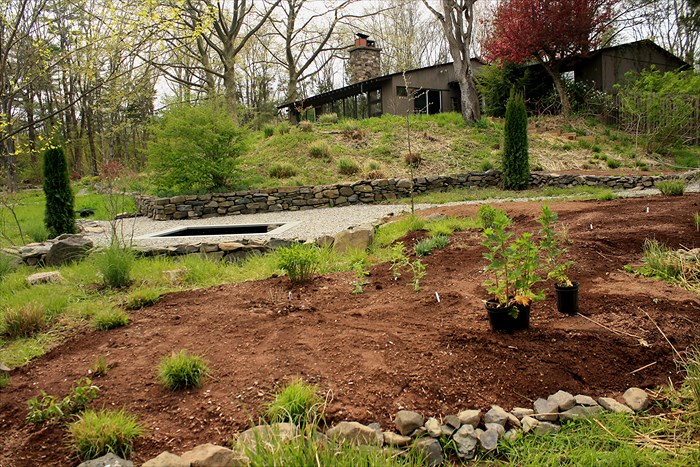Garden is a verb

"Garden is a verb," he said to me.Indeed. A garden is only finished when the gardener dies, or so the saying goes. Mine seems to be less finished with every passing day. Too many projects started over the winter, too much planting to be done.You can see above the new reflecting pool area surrounded by a low berm for planting. The berm covers a prominent path I've long wanted to erase from the garden. It resembles a lava flow, and suggests the flow of water across the garden in heavy rain, a wash of soil waiting for nature (or a gardener) to populate it with plants. (This "flow" metaphor is an underlying design motif of this garden.)The area still looks a mess but time has come to plant and deal with finish details. Will it look grown in by the June 29 garden tour deadline? I think so, at least enough to show the process of this garden. Once the weather warms, the grasses and perennials will grow quickly. What can't happen for several years is complexity, the interweaving of mixed growth that only comes from self seeding, natural spreading of perennials, and yet-to-be-conceived human interventions.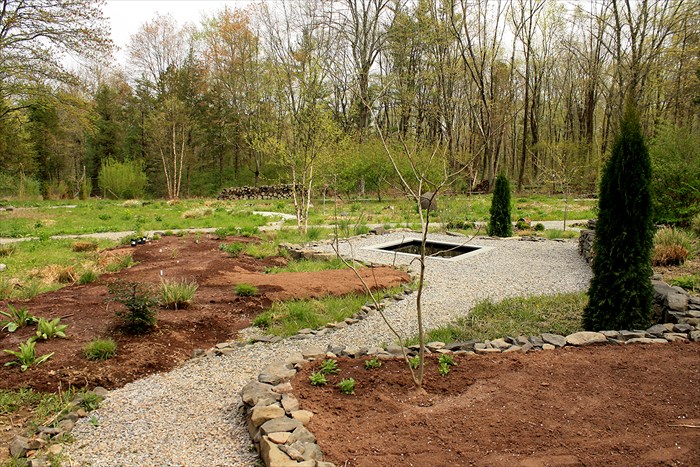 I'll continue to use mixed planting (methodically described in the new book by Noel Kingsbury and Piet Oudolf, Planting: a New Perspective), but my garden presents difficult constraints--that being heavy, compacted clay. Designing a planting for this garden is hit or miss. I certainly can't start with a design on paper that considers only physical appearance and characteristics of the plants over time. I'm no Oudolf and, if I were, it wouldn't do much good. Of the venue of extraordinary plants I know thanks to these two, many just can't grow here. (My garden offers a rapid death to any Echinacea, as one example.) Finding the plants that will grow takes trial, experimentation. Oh, I can follow some basic principles--use moisture-loving plants, avoid those that require "well drained" soil, favor those with long tap roots, not fibrous root systems, favor vigorous, competitive plants that spread rapidly--but only success over several years can prove a plant's ability to merely survive, or thrive, here.Now I'm at the planting stage and realizing just to what extent garden is a verb.To help get a more finished look quickly, I'm using large plants when I can get them: Rudbeckia maxima (five) in a group, several new and recycled Miscanthus, Panicums, two amazingly mature Baptisias I found at Paxson Hill Farm, and Pycnantheum muticum, which may eventually function as a matrix plant. I may even try to transplant some Inula racemosa seedlings for an immediate "mature" effect. Once the large plants are in, I have a mixture of other plants chosen for the dryer soil of the berm--20 Baptisia lactea, 10 Liatris ligustylis, several Angelica gigas, and a number of things to seed in: Prunella grandifolia as a ground cover, Bronze fennel, Verbena bonariensis, of course.
I'll continue to use mixed planting (methodically described in the new book by Noel Kingsbury and Piet Oudolf, Planting: a New Perspective), but my garden presents difficult constraints--that being heavy, compacted clay. Designing a planting for this garden is hit or miss. I certainly can't start with a design on paper that considers only physical appearance and characteristics of the plants over time. I'm no Oudolf and, if I were, it wouldn't do much good. Of the venue of extraordinary plants I know thanks to these two, many just can't grow here. (My garden offers a rapid death to any Echinacea, as one example.) Finding the plants that will grow takes trial, experimentation. Oh, I can follow some basic principles--use moisture-loving plants, avoid those that require "well drained" soil, favor those with long tap roots, not fibrous root systems, favor vigorous, competitive plants that spread rapidly--but only success over several years can prove a plant's ability to merely survive, or thrive, here.Now I'm at the planting stage and realizing just to what extent garden is a verb.To help get a more finished look quickly, I'm using large plants when I can get them: Rudbeckia maxima (five) in a group, several new and recycled Miscanthus, Panicums, two amazingly mature Baptisias I found at Paxson Hill Farm, and Pycnantheum muticum, which may eventually function as a matrix plant. I may even try to transplant some Inula racemosa seedlings for an immediate "mature" effect. Once the large plants are in, I have a mixture of other plants chosen for the dryer soil of the berm--20 Baptisia lactea, 10 Liatris ligustylis, several Angelica gigas, and a number of things to seed in: Prunella grandifolia as a ground cover, Bronze fennel, Verbena bonariensis, of course.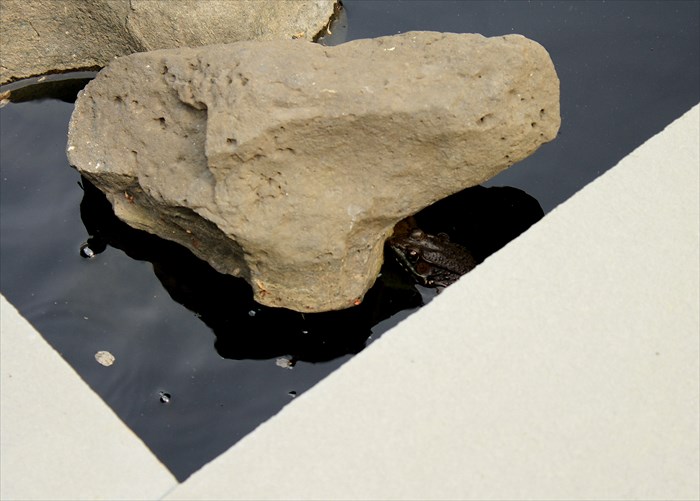 The frogs have even taken up residence in the new pool.
The frogs have even taken up residence in the new pool.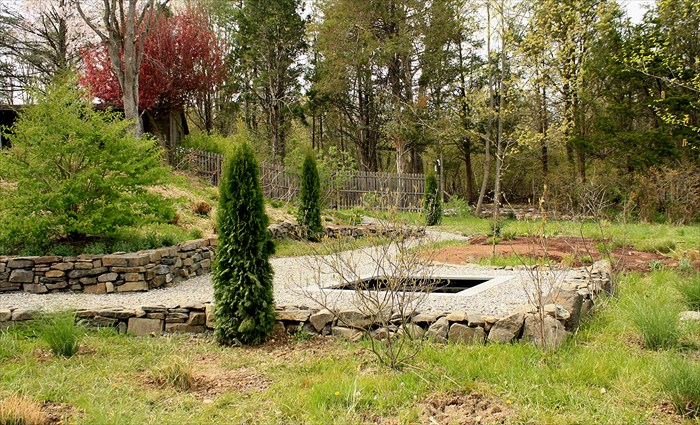 The rough grassy area in the foreground of the pool is being planted with Miscanthus, which copes very well with the wet and the compacted soil, and will be a ground cover. I'll scatter various Sanguisorbas among the Miscanthus mounds, and other things as I find what can thrive in this very damaged area (lots of tromping on the muddy clay last winter).
The rough grassy area in the foreground of the pool is being planted with Miscanthus, which copes very well with the wet and the compacted soil, and will be a ground cover. I'll scatter various Sanguisorbas among the Miscanthus mounds, and other things as I find what can thrive in this very damaged area (lots of tromping on the muddy clay last winter).
In addition to this new reflecting pool and planting berm on the east end of the house, we also added two stone-walled planting areas in the slowing evolving woodland garden on the west end.Here is the view up the path to the western woodland area.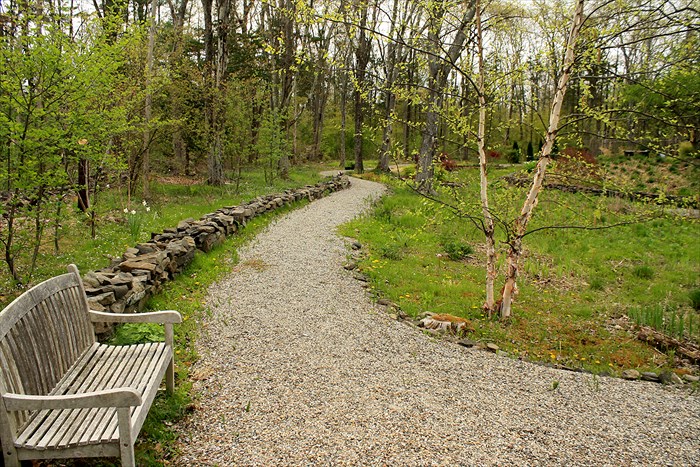 Lots of work left to do here. I moved Rodgersia to these elevated beds and planted Darmera peltata (roots, not plants), so it may be a while before the large foliage has impact.
Lots of work left to do here. I moved Rodgersia to these elevated beds and planted Darmera peltata (roots, not plants), so it may be a while before the large foliage has impact. This is a very wet area; the small scattered stepping stones don't work, visually or practically. I can't afford real stone, so I'm searching for alternatives.
This is a very wet area; the small scattered stepping stones don't work, visually or practically. I can't afford real stone, so I'm searching for alternatives.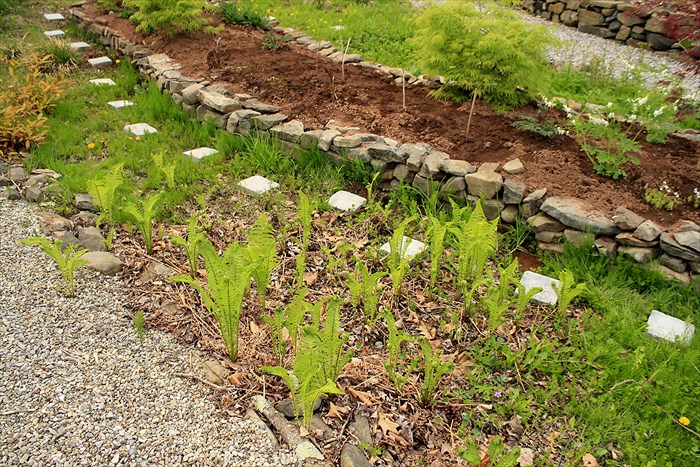 The surrounding area I'm trying to turn into a shady meadow. It's about half covered with Golden ragwort (Senecio aureus), as well as scattered ferns, Siberian irises, various carex and shade tolerent grasses, Sweet woodruff (Galium odoratum) and Pulmonaria.
The surrounding area I'm trying to turn into a shady meadow. It's about half covered with Golden ragwort (Senecio aureus), as well as scattered ferns, Siberian irises, various carex and shade tolerent grasses, Sweet woodruff (Galium odoratum) and Pulmonaria.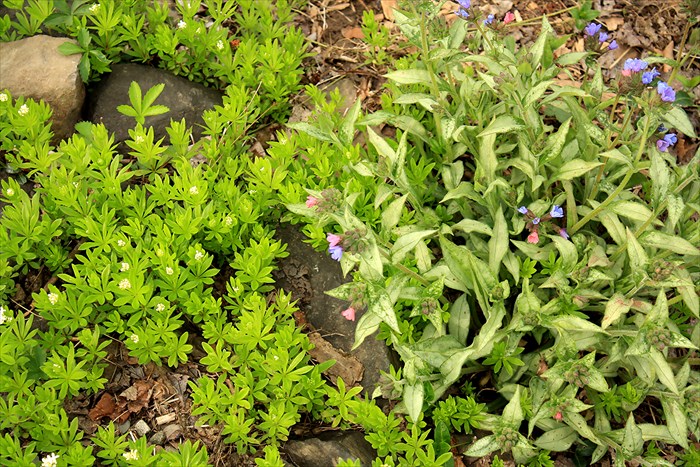 I've struggled with this wet, root infested end of the garden for years. The final solution may be a sea of Petasites.Success. Failure. Chance. Change.Garden is a verb.
I've struggled with this wet, root infested end of the garden for years. The final solution may be a sea of Petasites.Success. Failure. Chance. Change.Garden is a verb.
